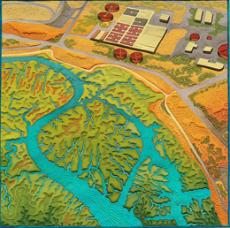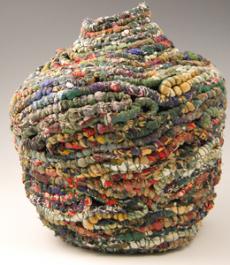
SHIRLEY GRIFFITH: I'm Shirley Griffith.
STEVE EMBER: And I'm Steve Ember with EXPLORATIONS in VOA Special English. Today we visit three current exhibits in Washington DC. Two of the exhibits are in the Smithsonian Institution's National Museum of American History. Both shows mark the 30th anniversary of the first official report about the disease AIDS. A third exhibit, at the Textile Museum, explores the importance and meaning of the color green.
(MUSIC)
SHIRLEY GRIFFITH: The United Nations estimates that more then 60 million people have been infected with AIDS in the past 30 years. The disease has killed at least 25 million. Last week, leaders and UN officials met for an AIDS conference in New York City. UN Secretary General Ban Ki-moon urged all countries to unite to provide HIV prevention, treatment and care to all people by 2015. HIV is short for the Human Immunodeficiency Virus – the cause of AIDS.
Today, it is common for members of the medical community, the media and aid organizations to talk about HIV and AIDS. But this was not always the case.
STEVE EMBER: Visitors to the Smithsonian's National Museum of American History can see two exhibits dealing with the early years of the AIDS crisis. One exhibit shows how the disease gained recognition as it spread during the early 1980s. The exhibit tells how the disease was misunderstood and misrepresented. It also tells how people slowly came to understand its causes and treatment choices.
SHIRLEY GRIFFITH: This exhibit is part of an area of the museum called "Science in American Life." It explores the early spread of HIV and AIDS, starting in 1981. It was in June of that year that America's Centers for Disease Control and Prevention first reported several cases of healthy young men dying in an unusual way. They were dying of diseases usually seen in older adults or people with weak natural defenses for fighting disease.

The men had several things in common. They were homosexual and lived in Los Angeles and New York City. Similar cases were also reported in people with the blood disease hemophilia and people who take drug injections. The CDC did not yet have a name for this disease.
STEVE EMBER: It was not until two years later that scientists identified HIV as the cause of the disease. HIV weakens the body's natural defenses for fighting disease. A weakened immune system enables pneumonia and cancer to spread. AIDS is short for Acquired Immune Deficiency Syndrome.
SHIRLEY GRIFFITH: The exhibit tells the story of the disease with written explanations, images, and historical objects. For example, visitors see several nearly 30 year old magazine covers dealing with the subject of AIDS. Exhibit notes say major news organizations did little reporting on AIDS before 1983. The exhibit says discriminatory beliefs about homosexuals meant that stories about gay men dying were not considered of interest to the general public.
STEVE EMBER: Other objects in the exhibit include the first HIV test and a bottle of azidothymidine, or AZT. This drug was the first approved treatment for HIV. It was made available in 1987 under the name Retrovir. There is a large image of the AIDS Memorial Quilt when it was placed on Washington's National Mall in 1987. The quilt is made from thousands of pieces of cloth. Family members and friends of AIDS victims created each piece as a way to remember those who died of AIDS.
Museum visitors also can see objects worn by early AIDS activists in the United States. They accused the administration of President Reagan of remaining silent about the disease. It was not until 1987 that Mister Reagan declared AIDS "public health enemy number one."
SHIRLEY GRIFFITH: The second exhibit at the National Museum of American History is part of the museum's Archives Center. It brings attention to recorded stories and materials that helped raise awareness and understanding of the disease. For example, a collection of trading cards was published in the early 1990s to raise awareness about AIDS among young adults. They show the images of famous people, such as Madonna and Elizabeth Taylor, and how they have helped in the fight against AIDS.
The exhibit also includes objects like AIDS related movie posters and a collection of interviews. The Archives Center says its many objects give researchers a way to learn how individuals and society dealt with the AIDS crisis.
(MUSIC)
STEVE EMBER: Washington's Textile Museum currently has an exhibit called "Green: the Color and the Cause." Clothing, floor and wall coverings, and other objects there show how different cultures over time have linked the color green with nature, life, fertility and rebirth. The show also explores the modern meaning of green as representing the environmental movement.

SHIRLEY GRIFFITH: A quilted work by artist Linda Gass hangs in the entrance of the exhibit. Rebecca Stevens organized the exhibit. She says the work brings together the many subjects in the exhibit. To create the work "Treatment," Ms. Gass used cloth and paints to create an image of a water treatment center on the San Francisco Bay. The brightly colored cloth image looks like a photograph of land and river taken from an airplane.
REBECCA STEVENS: "What the artist is focusing our attention on is the question of where do you put a treatment plant? How do you preserve the nature around it? But how do you treat the water so that you can sustain the human population?"
STEVE EMBER: Ms. Stevens says this question of balance between protecting nature and supporting human activities is raised in different ways in the exhibit. The Textile Museum invited many artists to take part in the show. It also appealed to artists around the world. The museum received over 1,000 entries from over 300 artists. Artists from five continents are represented in the show. The exhibit's many historical pieces are from the museum's large permanent collection.
SHIRLEY GRIFFITH: One ancient woven work is nearly 2,000 old. The small piece of cloth was made in Egypt in the fourth century. It shows a woman wearing green clothing, with a neckpiece of flowers and green leaves. In one hand, the woman is carrying a bundle of grain. Experts believe she represents the Earth, or one of its seasons. Either way, the artist used green to express nature's richness.
STEVE EMBER: Until the creation of man-made dyes in the late 1800s, it was difficult to make clothing and cloth products in the color green.
REBECCA STEVENS: "Green is a very difficult color to make as a dye, to dye a textile green, because it is not permanent. Despite the fact the world is green, covered with plants and trees, there is no one natural dye that makes green, a colorfast, permanent dark green."
STEVE EMBER: But Ms. Stevens says artisans were inventive in finding an answer around this problem.
REBECCA STEVENS: "Cultures around the world came up with the same concept and that is, to dye the textile yellow, and then dye it with a blue which was often indigo or woad, mostly indigo, and that is how they would achieve green."
STEVE EMBER: One skilful artist in 19th century China found an inventive way to create green. The artist used feathers from a bird – the peacock - to create a shiny green color. The very detailed cloth was probably used in Buddhist ceremonies.

SHIRLEY GRIFFITH: Artist Nancy Cohen created a large piece called "Estuary: Moods and Modes." It is a three dimensional representation of a protected river system in the state of New Jersey. She made the work from handmade yellow, blue and green paper. It extends over the walls and floor of an entire room in the exhibit. The artist says the piece shows how interdependent parts hang in balance.
STEVE EMBER: Other artists in the exhibit use unwanted or reused materials in their art to express the environmental meaning of "green." Artist Jackie Abrams spent time living and working with women basket weavers in Ghana. She says she was influenced to make baskets using waste materials. Her colorful artwork "A Woman of Substance" is a container made from old pieces of women's clothing. Artist William Knight used old automobile tires to make an airy and finely cut wall sculpture.

SHIRLEY GRIFFITH: One piece in the Textile Museum's "Green" exhibit is a work in progress. Michelle Brody's "Arbor Lace" is an outdoor structure with a frame made from copper pipes. The frame is covered in a see-through white material that holds grass seeds.
REBECCA STEVENS: "In the course of the time that the exhibition will be on view, the grass will sprout, and grow and die. And so she wants to have a visual representation of life's cycle."
SHIRLEY GRIFFITH: This work, like others in the exhibit, brings together the meaning of green both as a color and a representation of nature and the environment.
STEVE EMBER: This program was written and produced by Dana Demange. I'm Steve Ember.
SHIRLEY GRIFFITH: And I'm Shirley Griffith. Join us again next week for EXPLORATIONS in VOA Special English.
hemophilia: 血友病
azidothymidine: 叠氮胸苷,一种治疗AIDS的药
estuary: the wide part of a river where it flows into the sea(江河入海的)河口,河口湾
Children of AIDS face mental health needs
AmfAR's Cinema Against AIDS 2011 event in Antibes at the 64th Cannes Film Festival
How early treatment can limit the spread of HIV
Words and their stories: green expressions
(来源:VOA 编辑:崔旭燕)
